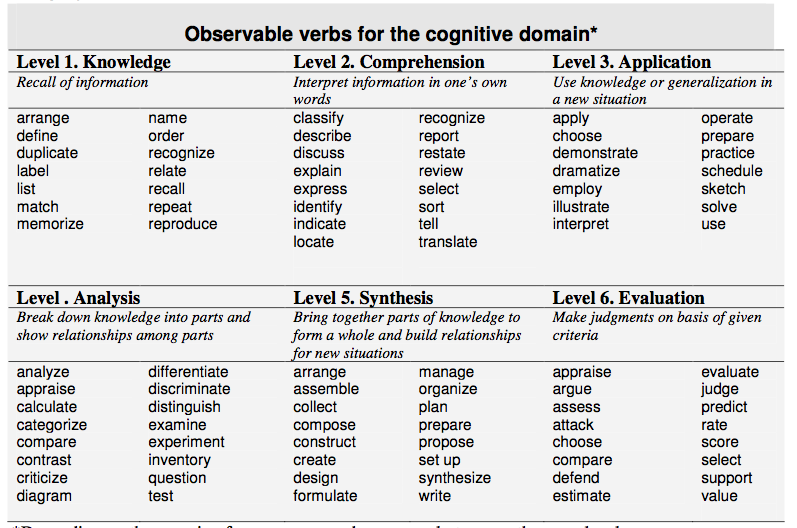Learning objective: Difference between revisions
No edit summary |
m (→References) |
||
| Line 42: | Line 42: | ||
[[CAtegory : Educational modeling languages]] | [[CAtegory : Educational modeling languages]] | ||
[[Category : Pedagogical scenarios]] | [[Category : Pedagogical scenarios]] | ||
[[Category: Taxonomies]] | |||
Revision as of 18:01, 3 December 2010
Definition
Learning objectives are statements that define the expected goal of a curriculum, course, lesson or activity interms of demonstrable skills or knowledge that will be acquired by a student as a result of instruction. Also known as : Instructional objectives, learning outcomes, learning goals,
=Introduction= The definition of learning objectives is (or should be) the foundation of any instructional design. They are integral determining factor of strategies and Instructional design model and methods, pedagocial scenarios and lesson plans.
Problems defining learning objectives
Learning objectives when attained should be observable behaviours or actions. Words used to define learning objectives are often teacher centered and ambiguous.
E.g. Students will know the seven original member countries of the European Union and their capitals.
Formulations such as "Student will understand, comprehend, know" are problematic in that one cannot observe knowing or comprehension. Learning objectives should be formulated in a way that specifies how learning will be observed or measured and are thus intertwined with evaluation methods. Words that describe what the student will do to show that he or she understands are more useful.
E.g. Students will be able to list 5 countries in Europe and their capitals.
Related articles
Verbs for defining learning objectives
Verbs presented in the following table are lists of verbs that correspond to the cognitive domains within Bloom's Taxonomy from CyberCampus's Tips for writing performance-based objectives.
Source:Kemp, J.E., Morrison, G.R., & Ross, S.M. (1998). Designing effective instruction, 2nd ed. Upper Saddle River, NJ: Merrill
Tools
- Online Objectives Builder Tool based on Bloom's taxonomy with presenation tutorial
Links
- Online objectives builder tool - blog entry describing the tool
- Overview of Instructional Objectives from Purdue University
- Mager's Tips on Instructional Objectives - overview of Mager's Preparing instructional objectives provided in a course at Georgia State University
References
- Mager, R.F. (1984). Preparing instructional objectives. (2nd ed.). Belmont, CA: David S. Lake.
- Cybercampus, Golden Gate University, Tips for writing performance-based objectives, accessed November 16, 2009.
